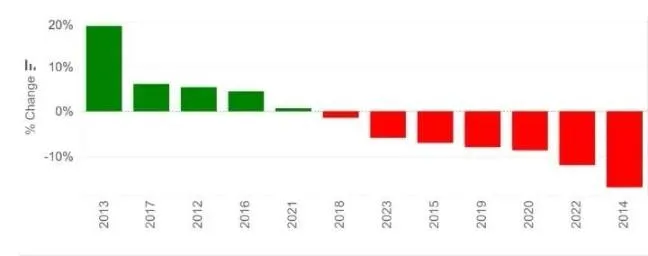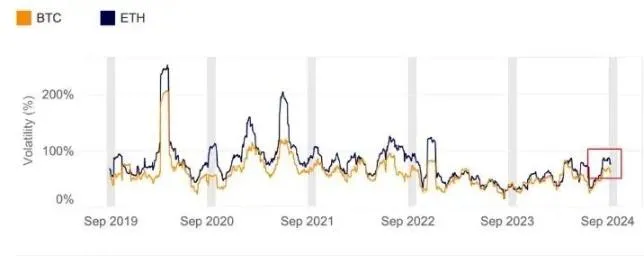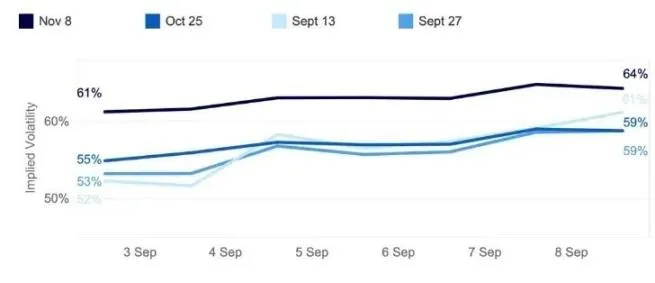Bitcoin Price Trends and U.S. Rate Cuts: 4 Key Charts

The current landscape for Bitcoin (BTC) and the broader cryptocurrency market is undeniably challenging. Seasonal fluctuations in September have compounded the difficulties, leading to increased uncertainty.
In a recent report, Kaiko researchers explored how potential U.S. interest rate cuts and other key economic events might influence BTC’s price trajectory. Here are four charts provided by analysts that shed light on Bitcoin’s outlook in the coming weeks.
Bitcoin’s Historically Poor Performance in Q3
Historically, the third quarter has been particularly difficult for BTC and the wider crypto market. September, in particular, has consistently produced poor returns, with Kaiko emphasizing that Bitcoin has experienced negative performance in seven of the last twelve Septembers.
In 2024, this pattern continues, with Bitcoin dropping 7.5% in August and an additional 6.3% so far in September. As of now, Bitcoin is trading 20% below its all-time high of nearly $73,500, reached over five months ago.
However, there might be a glimmer of hope on the horizon. According to Kaiko Research, a forthcoming U.S. interest rate cut could potentially provide a boost for BTC and other risk assets. Bitget Wallet’s COO, Alvin Kan, echoed this sentiment, stating that the market might be in for some relief.

Impact of Potential U.S. Interest Rate Cuts
During a speech at the Jackson Hole Symposium, Federal Reserve Chairman Jerome Powell hinted at a possible policy adjustment, leading to widespread speculation about future interest rate cuts. The U.S. dollar index reacted by dropping sharply and is now hovering around 100.
Alvin Kan noted, “As expectations for a September rate cut become more widespread, the beginning of rate cut trading could improve overall market liquidity, which could serve as a catalyst for crypto assets like BTC.”
The report further highlighted that September is likely to remain a highly volatile month, with Bitcoin’s 30-day historical volatility expected to soar to 70%. This metric measures BTC’s price swings over the past 30 days, reflecting intense market fluctuations.
Bitcoin’s current volatility is nearly twice the level seen last year, approaching its peak from March, when BTC hit its all-time high.

Implied Volatility and Short-Term Market Stress
Implied volatility (IV) for BTC has also risen since early September, after declining in late August. This metric, based on current options trading activity, gauges market expectations for future price swings. A higher IV suggests that traders anticipate more significant price movements, though it does not specify the direction.
Interestingly, the largest increase in IV occurred for options expiring on September 13, with a jump from 52% to 61%, surpassing contracts expiring at the end of the month. When short-term implied volatility exceeds long-term IV, this reflects increased market stress and is known as an “inverted structure.”
This inversion typically signals heightened uncertainty or market pressure. Risk managers often interpret such shifts as a warning to reduce exposure to volatile assets or hedge against potential downside risks.

Kaiko researchers noted, “Market expectations align with last week’s U.S. jobs report, which dampened hopes for a 50 basis point rate cut. However, the upcoming U.S. CPI data could still influence market sentiment.”
Trading Volume and Market Activity Surge
The fourth chart in the report focused on Bitcoin trading volumes, which highlight the current volatility and growing trader participation.
Cumulative BTC trading volumes are nearing a record $3 trillion. After reaching a previous peak in 2021, volumes have grown nearly 20% in the first eight months of 2024.

Traditionally, BTC investors have viewed interest rate cuts as a positive market catalyst. However, there remains concern over whether rate cuts exceeding market expectations could be misinterpreted as a sign of deeper economic troubles.
Markus Thielen, founder of 10X Research, warned that a 50 basis point rate cut might signal urgency, potentially triggering a pullback in risk assets like BTC.
In a note to clients, Thielen remarked, “While a 50 basis point cut by the Fed might indicate deeper concerns, the Fed’s priority is to mitigate economic risks rather than manage market reactions.”
Additional Factors Contributing to Market Volatility
Beyond speculation around interest rate cuts, other events continue to drive volatility in the cryptocurrency market.
The upcoming U.S. elections are one such factor. According to reports, debates between Trump and Harris are expected to stir market uncertainty, particularly impacting BTC and Ethereum.
Summary
While Bitcoin’s performance in Q3 has followed historical patterns of underperformance, potential U.S. interest rate cuts may provide a lifeline to the crypto market. However, the degree of rate cuts and the broader economic outlook will ultimately determine whether BTC experiences a sustained rebound or continues to face headwinds.
Additionally, short-term market stress and external events, such as the U.S. elections, could further exacerbate price volatility for both Bitcoin and other crypto assets.